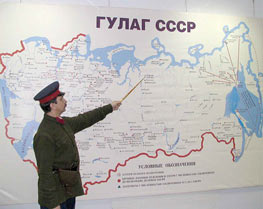| RTG |
Russia |
Travel Group |
|
 |
 |
Your insiders in Russia
www.r-tg.com
|
| Toll free phone |
| 1-866-387-5141 |
| USA office phone |
| 1-770-789-4664 |
|
|
|
|
|
 |
|
|
| |
In order to send a request or get more detailed information please contact travel@r-tg.com or fill in the booking forms below:
Tours Order Form
Hotel Order Form
Transfer Order Form
Tickets Order Form
or call us at our toll free number 1-866-387-5141.
Museum of Gulag History (New) The museum impresses on visitors the enormous size of the Gulag system. A large map of the Soviet Union shows the vast network of camps across the country. It provides information  about the colossal construction projects driven by prison labor, such as the Moscow-Volga Canal, which cost hundreds of thousands of lives. The map shows there was even a camp on Vrangel Island, one of the most remote and inhospitable places in a country with a lot of competition for that title. The museum, which works with the Federal Archive Agency, is currently limited to an exhibit about political prisoners in the Gulag, acronym for the Main Administration of Corrective Labor Camps. A system of forced-labor camps was created in 1919, shortly after the Bolsheviks seized power. After a series of organizational changes in the 1920s, the system was consolidated as the Gulag in 1930. By 1936, it held some 5 million prisoners. The Gulag was filled in three main waves — during the collectivization of agriculture in the late 1920s and early 1930s, the purges of 1936-38 and immediately after the end of World War II. about the colossal construction projects driven by prison labor, such as the Moscow-Volga Canal, which cost hundreds of thousands of lives. The map shows there was even a camp on Vrangel Island, one of the most remote and inhospitable places in a country with a lot of competition for that title. The museum, which works with the Federal Archive Agency, is currently limited to an exhibit about political prisoners in the Gulag, acronym for the Main Administration of Corrective Labor Camps. A system of forced-labor camps was created in 1919, shortly after the Bolsheviks seized power. After a series of organizational changes in the 1920s, the system was consolidated as the Gulag in 1930. By 1936, it held some 5 million prisoners. The Gulag was filled in three main waves — during the collectivization of agriculture in the late 1920s and early 1930s, the purges of 1936-38 and immediately after the end of World War II.
Estimates vary as to how many prisoners passed through the system; Alexander Solzhenitsyn, whose book "The Gulag Archipelago" first revealed the horrors of the system to people around the world, claimed that 40 to 50 million people served lengthy sentences in the Gulag from 1928 to 1953. Some Western scholars estimate that as many 30 million people died in the camps from 1918 to 1956. Following the death of Stalin in 1953, the population of the camps decreased dramatically as the result of mass amnesties. The Gulag itself formally ceased to exist when its activities were taken over by various ministries and the camps were placed under a new organization, the GUITK, or Main Administration of Corrective Labor Colonies.
|
|
| |
|
|
 |
|
|
|
|
|
|
| |

